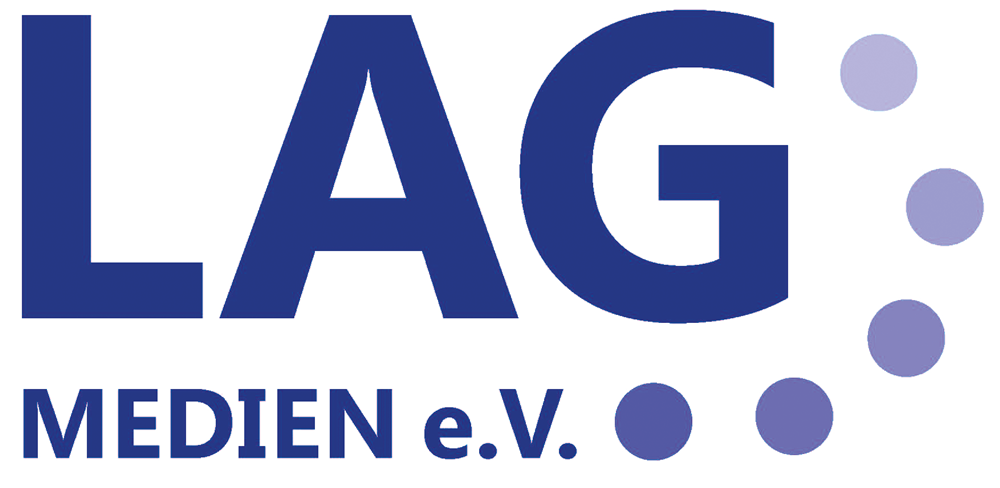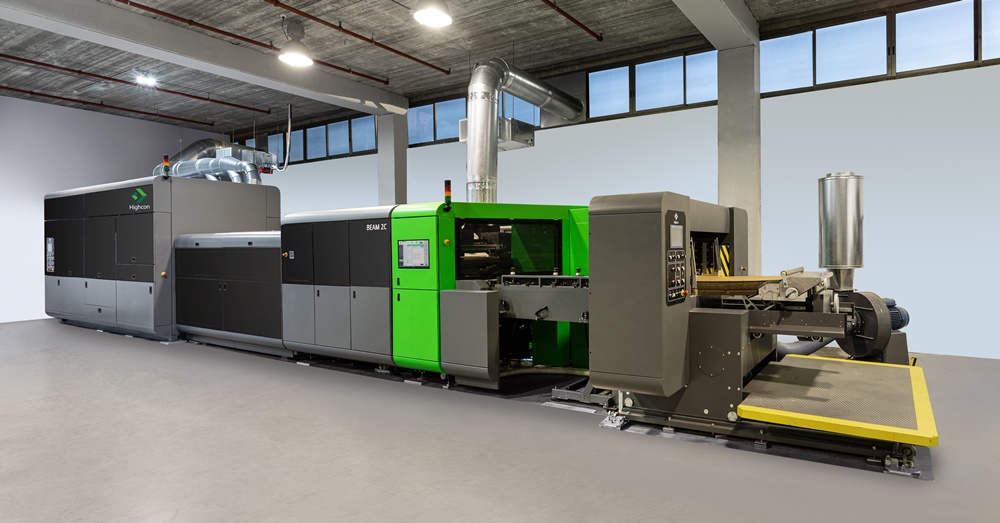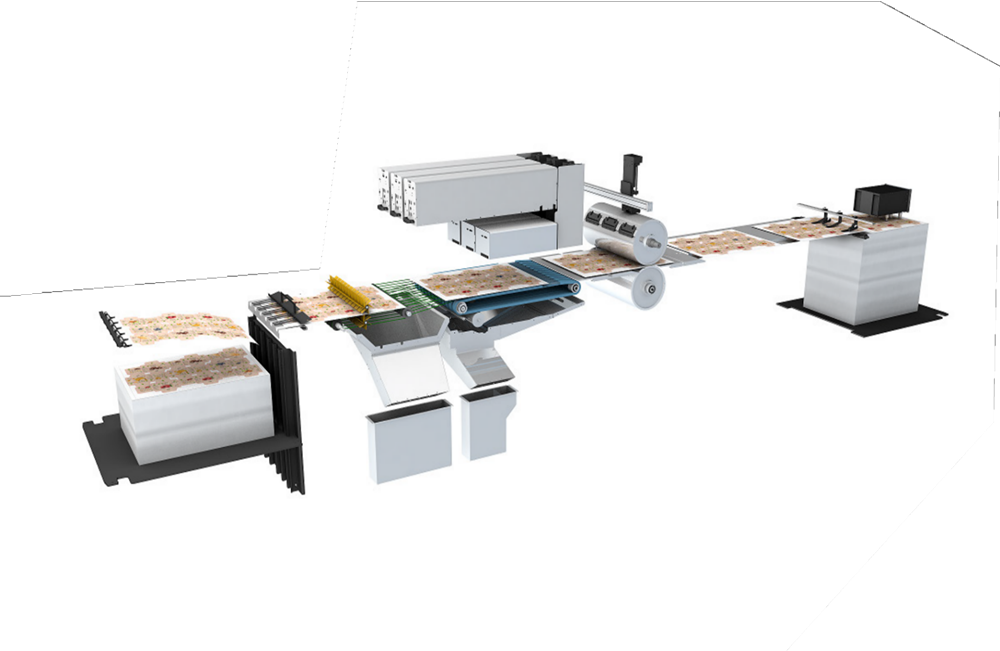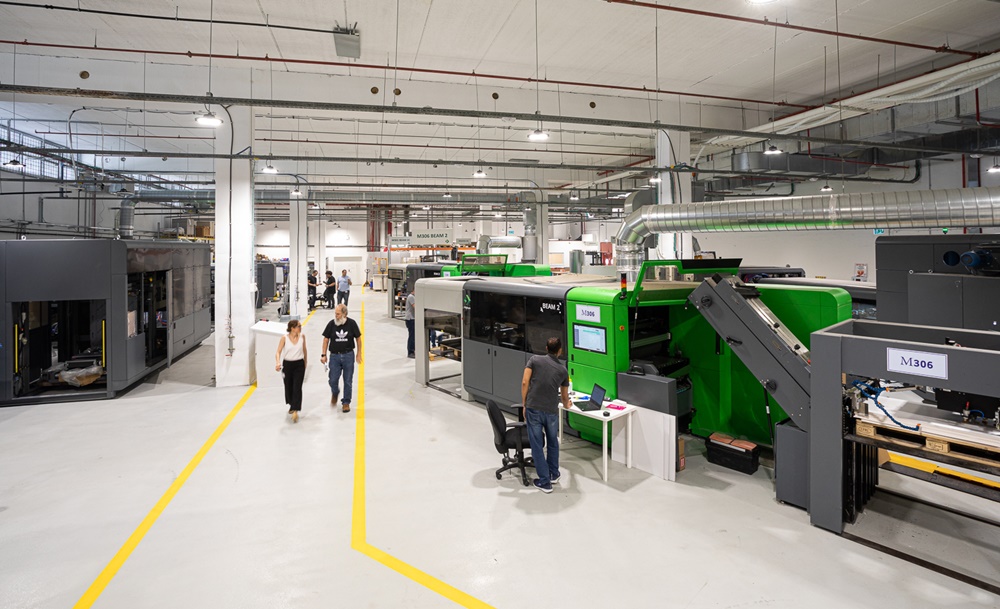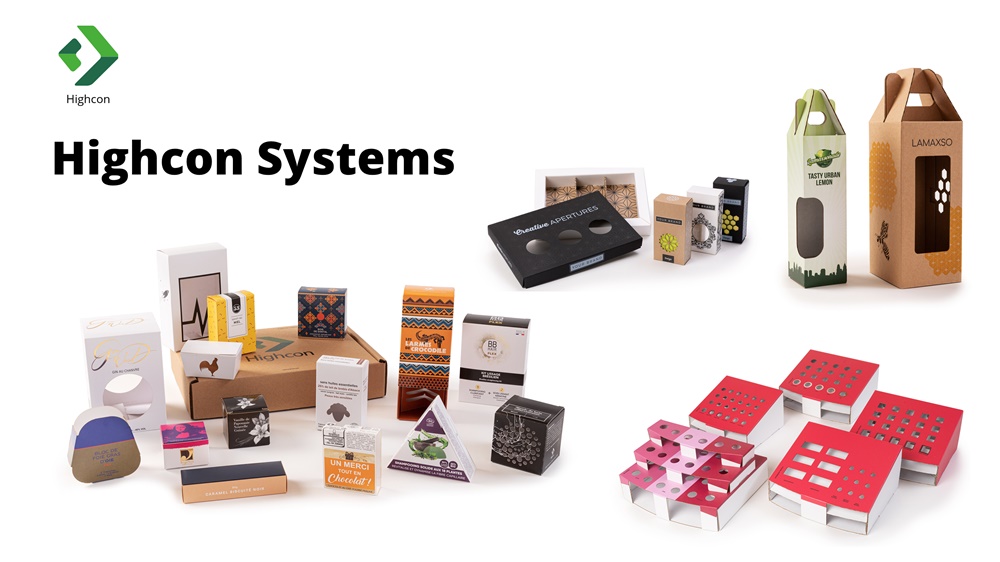P3 3-4/2023 en
Highcon
The Digital Solution for Improved Productivity and Sustainability
Finishing Technology
For over 100 years, the industrial packaging industry has used traditional physical die-cutting tools to produce packaging templates that facilitate the transposition of two-dimensional flattened templates into three-dimensional boxes. And, like many analogue processes, conventional die cutting is labour- and material-intensive making it an expensive and environmentally challenging process. Moreover, with increasing demand for shorter and customized runs, the conventional manufacturing method that works well for longer runs, no longer fits the needs and time to market requirements when it comes to short volume applications.
Sustainable packaging is not just about the package itself, but the entire process.
Converting materials without the use of dies is an attractive option, as it enables cost-effective production of short to medium run lengths, meeting, and in some cases exceeding, the capabilities of conventional finishing processes. Digital Finishing solutions replace cumbersome, time-consuming analogue processes with more agile, quicker, and cost-effective digital techniques. In addition to increasing capacity and flexibility in the production process, converters already benefiting from the analogue-to-digital transformation are also more likely to manufacture sustainably because waste and inventory are significantly reduced.
The digital difference
Digital Finishing differs from conventional packaging methods, which include die cutting and creasing in one tool. Digital Finishing involves laser cutting and digitally-driven creasing. Highcon’s patented Digital Adhesive Rule Technology, DART, creates the creasing scheme in a matter of minutes, to dramatically stream line the process. Resulting in less material waste and simplified logistics; such as no more die ordering and storage. What used to take hours of labour for the converter, is now done cost effectively through a digital process.
Another difference between Digital Finishing and the traditional linear analogue process is that utilizing the traditional method requires a step-by-step process for each package. Every job requires a different set up on each piece of equipment which results in an adverse setup-to-run ratio when the runs are short. To optimize production runs based on an entire shift (or more) and not merely a single job, a digital manufacturing approach is what is required.
Highcon’s digital creasing and die cutting systems allow converters to dynamically gang jobs and obtain substantial reduction in operational expenses and time. A digital manufacturing approach collects job specifications, which are then dynamically ganged using AI-driven imposition software to reduce makereadies and costs. Digital die-cutting is then applied to the printed board to achieve affordable and efficient small run and dynamically-ganged jobs. This approach is applicable to both digitally printed and conventionally printed jobs. Digital finishing can also help converters gain more agile production planning, enabling them to take on more rush jobs, streamline processes and improve efficiency.
So how does digital finishing work?
In a Highcon production run, sheets start with the feeder, which is easy to setup and maintain. Sheets undergo an initial mechanical alignment and then pass through sensors that detect and compensates for variations between prints. A photopolymer material, developed and manufactured by Highcon is used to write the creasing rules, providing the strength and durability needed for high speeds and consistent performance. Rules are written, then cured under a UV lamp for high strength and durability.
As part of the setup process, a fresh PET foil is mounted, the layout file is loaded, the system reads the creasing information in the file, and the crease rules are extruded onto the foil.
The sheets are then passed through Highcon DART creasing station, where physical creases are applied. Rule height is adjusted to suit the application and stock at hand during the writing process. As each sheet passes through the creasing station, it is pressed between drums; the upper drum holding the creasing rules and the lower drum holding the blanket applying counterpressure. This fulfils the same role as the female plate in conventional die cutting.
Once the sheets have been creased, they advance to a module where multiple lasers cut the sheet simultaneously. By using high-powered lasers, converters can achieve innovative designs and offer segmented products based on region, demographic, and season – specifications which are impossible to apply with the traditional analogue process. Lasers cut every sheet precisely, and if needed, add fine details, enabling converters to offer their customers innovative packaging and customization options, all at a competitive price.
Next, the sheets are moved to the inline digital stripping station, where all the residual cut paper is removed from the sheet's inner section. This station does not require tooling, so there is no additional setup time or tooling cost., the waste is brushed off and dropped into disposal bins. As the sheets move on, they are safely and neatly stacked in a readily accessible stacking unit.
What makes digital finishing sustainable?
Sustainable packaging is not just about the package itself, but the entire process, from the sourcing of materials and shipping, to the type of energy used to power the plants, and the different processing steps in the manufacturing process. Highcon Digital Finishing represents a technological edge and sustainable alternative to traditional die-cutting. In addition, digital finishing is ideal for on-demand production, reducing inventory.
The three key sustainability benefits of Highcon digital die cutting versus analogue alternatives are:
- No dies: By selecting digital (over analogue with its carbon footprint approximately eight times greater than the Highcon DART foil) you can now eliminate mixed-material die sets and their multi-year storage that consume space and energy. You can also reduce die set disposal at landfills by up to 98% in relative volume.
- Non-crush lightweighting: Highcon’s non-crush combination of laser cutting and creasing, minimizes damage to the integrity of the corrugated board. As compared to analogue die-cutting, the board and resulting packages are materially stronger and permit Lightweighting – the use of lighter weight boards and less material used in the package. Downstream, this leads to savings in transportation costs and emissions.
- Mono-material packaging: With Highcon’s Digital Finishing, it is both affordable and feasible to use cardboard, microflute, or corrugated inserts. You can use mono-material packages - inserts made of the same material as the package itself. This has a significant impact on the environment in that used materials can be delivered into recycling streams without contamination from plastics or other synthetics.
Implementing a digital shift
The German-based Thimm Group recently presented their digital vision of the “Internet of Packs” to CCE 2023 attendees. This vision involves virtually no lead times, no MOQs, and fully sustainable packaging.
Thimm is a provider of products corrugated packaging including boxes, promotional displays, and products for the consumer goods industry. In 2020 they invested in a Highcon Beam 2C digital cutting and creasing system for their pack’n’display facility in the Czech Republic. Thimm claims to have already reduced lead times by 75% and MOQs by 90% through innovative digital technologies.
”We are using the Highcon Beam 2C in our Czech plant for our promotional business, and this is really bringing down MOQ, even to a single piece if you like,” said Michael Weber, Director Corporate Strategy and Marketing, Thimm Group. “Highcon is one of our enablers for our digital vision, helping us transform our digital die cutting and creasing to bring forward our Internet of Packs vision.”
“Today we can provide a corrugated box or a corrugated display in less than five working days and for all of you that know this industry, you know that five days is really less time. The good news is 75% [lead time reduction], even better news is five days to go. Our vision is to bring it down to one day,” said Weber.
Another Highcon customer, Heuchemer Verpackung, a family-owned and run corrugated packaging manufacturer based in Germany, took their first steps into the digital world in 2019. With a complete digital workflow, Heuchemer can customize product structure to optimize box size and offer customers complex shapes, customized perforations with cleaner edges and easier opening, and variable data etching for personalization.
To meet high demand for e-commerce and short-run quick turnaround jobs, Heuchemer further expanded operations by establishing lamaxso.com two years ago. The e-commerce platform serves a wide variety of small and regional businesses with agile responses to spontaneous packaging requirements based on seasonal demand, local needs, etc. All this with no minimum order quantities. Lamaxso also delivers quick test runs for new products that can be realized without significant delays.
According to Sophie Heuchemer-Flügge, co-owner and director of R&D, Heuchemer Verpackung, the investment in Highcon has extended the company’s expertise in packaging development to new customers - offering smaller print runs and demand for high flexibility such as ways of coping with order variations and personalized boxes.
“We wanted to focus on giving the right solution, for your business,” said Heuchemer. “If you are selling honey, you can find something especially for this, if you are in cosmetics, you will find packaging for this need, and if you are selling beer or wine, we have boxes for this.”
So, should you consider a move to digital finishing now?
The shift to digital is inevitable in almost all areas of short to medium run printing and packaging. It meets the challenges of sustainability and productivity - with tooling costs eliminated and short run production cycle times markedly reduced. It reduces or erases the potential for bottlenecks, and helps converters and brands diversify and grow.
But that’s not all! Digital Finishing is also an ideal technology to help meet another huge global challenge - labor shortages. In comparison to conventional technology, Highcon Systems require fewer skilled operators to operate the system and manage the workflow, and training takes only two weeks, rather than six to twelve months.
Now is the best time to adopt this technology. Digital Finishing is being implemented globally and can be a significant step in equipping your business for a successful future.



